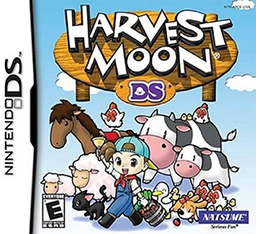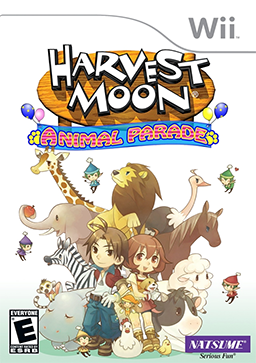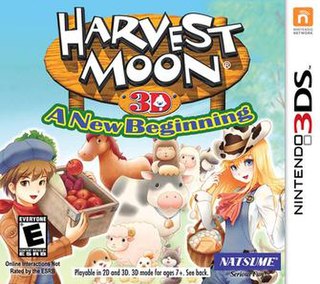Opening Scene
When the player begins the game, they see a coastline in Forget-Me-Not valley. Takakura, an old man who used to be the protagonist's father's best friend, is speaking (or thinking) to his father, stating: "He wasn't unhappy. But he didn't seem to have a direction in life. One day, I went to see him. I told him about the farm you left to him. Your son didn't seem to know much about farming, but he was willing to give it a try. So I brought him to Forget-Me-Not-Valley.". The protagonist (who is by default named Mark in Harvest Moon: A Wonderful Life Special Edition) is then seen walking down the village with Takakura, and he explains how he and the protagonist's father owned the farm. He then shows the protagonist the barn, the tool shed, the chicken coop, the food storage, the protagonist's house, and his house. Soon, two dogs will appear and the protagonist chooses one to keep while Takakura attempts to find an owner for the other one. Takakura agrees to show the protagonist around the valley and introduce him to the villagers: Tim, the owner of the Inner Inn, his wife Ruby, and their son Rock; Nami, a girl staying at the Inner Inn, Wally, an athlete, his wife Chris, and their son Hugh; Galen and his wife Nina; Griffin, the owner of the Blue Bar and his daughter Muffy; Romana, her granddaughter Lumina, and their butler Sebastian; Vesta, a farmer, her brother Marlin, and their helper Celia; Kassey and Patrick, pyrotechnic twins who create fireworks; Cody, an artist; Daryl, a scientist; Gustafa, a musician; and Carter, a scholar, and his assistant Flora. Celia, Nami, and Muffy are the eligible bachelorettes (in Harvest Moon: A Wonderful Life Special Edition, Lumina is also a bachelorette). Additional characters include a doctor named Dr. Hardy, a salesman named Van, and a homeless guy named Murray. Afterwards, the protagonist meets the Harvest Sprites: Nic, Nak, and Flak.
Story
- The Beginning
In this chapter, lasting a year, the protagonist begins in his house at 5 AM. The player is now in control of the game, and starts with a cow, a milker, two records, a hoe, a sickle, a watering can, two tomato seeds, and 3000G. The Lodger in the food storage can be used to purchase more tools, animals, and buildings, or to sell animals. Sometime in this chapter, the protagonist will receive a horse from Takakura for free if he is befriended and a rare blue feather from the Harvest Sprites, which can be used to propose to one of the bachelorettes at the very end of the year. Heart Events can be triggered by wooing the bachelorettes. The Seed Maker may be obtained either by befriending Daryl or purchasing it using the Lodger. New tools can be obtained from people if they are befriended such as a wool clipper from Wally, a watering can from Romana, two hoes from Tim and Vesta, and a sickle from Gustafa. A fishing pole and brush can be bought from Van. The protagonist may have a chance to meet Mukumuku, a creature that only appears in the winter. Throughout the story, Daryl attempts to capture Mukumuku, but is constantly thwarted by Murray and potentially Van. There are also side quests to do such as unearthing things at the dig site (if you find any tablets, then Carter gets to keep them) and giving Murray the money he needs to go home. If Murray is given enough money, he will reward you. Additional events can be triggered such as engaging in a conversation with Lumina while she's practicing piano or observing Daryl conduct an experiment that will suddenly backfire. The protagonist must marry one of the bachelorettes in this chapter, or he must leave the town and lead to the game's end. Celia is the easiest bachelorette to woo while Nami is the hardest. Celia will propose to the protagonist should he not successfully woo any of the bachelorettes. Refusing this proposal will also cause the game to end.
- Happy Birthday
In this chapter, lasting two years, the protagonist has a son whose personality depends on his mother. The protagonist's house will now have a kitchen and dining room, and will also gain a refrigerator and two bathrooms. The main room now has an additional bed and a toy box containing a sketch pad. The dig site also gets bigger. Some characters' appearances has changed and new people (consisting of Kate, Grant, Samantha, and Dr. Hardy) move in. An additional house is now in the village. If the protagonist does not marry Nami, she will leave town. Van now sells toys that can be put in the toy box and a goat (which also comes with a milker), which may only be purchased in spring. Galen has moved, and now lives in a shack on hill beside Vesta's farm. Nina has died of natural causes and her grave is beside Galen's shack. Dr. Hardy now lives in Galen's old house, in which the protagonist can have a chance to meet him. Starting from this chapter, the protagonist may receive a cat from Romana if she is befriended, the toddler can be picked up and played with, a sentient plant named Tartan may be acquired if Takakura is befriended, an alarm clock may be obtained from Grant if he is befriended, ducks may show up at the protagonist's farm if a pond is owned, a sickle can be obtained from Dr. Hardy and a fishing pole from Galen if they are befriended, Grant may inform the protagonist that he now has a job in a city located outside of town, the protagonist may have the option to take a bath with the son and learn about the Harvest Goddess (who doesn't appear in the game) from the Harvest Sprites, Chris and Samantha can be seen having a conversation, and Daryl can be caught doing suspicious activities such as spying on the son, attempting to experiment on the protagonist's cows, and spying on Carter and Flora (whom he has a crush on). If Tartan is befriended, the protagonist can use him to create hybrid crops. Failing your married life will result in a divorce, which will cause the game to end.
This chapter was renamed to "A Birth" in Harvest Moon: A Wonderful Life Special Edition and the protagonist's child may be a daughter instead of a son. There will also be additional events that did not happen in the original version which the player can trigger.
- Happy Harvesting
In this chapter, lasting three years, the protagonist's son has grown into a seven or eight-year-old and can no longer be picked up and played with. Hugh and Lumina's appearance have changed again and the protagonist's house and dig site have expanded. The son's future career may be swayed by befriending villagers with similar careers or giving him items obtained from other characters (if befriended) such as a drum from Gustafa, a music sheet from Lumina, the Ruby Spice from Ruby, and a necklace from Flora. Nami returns in this chapter (if the protagonist does not marry her). The protagonist can also buy a sentient teddy bear named Daa-chan from Van, who may be seen trying to steal food from the refrigerator or spending time with the son. At one point, Dr. Hardy can be seen talking to Mukumuku.
- Happy Farm Life
In this chapter, lasting two years, the protagonist's son is a teenager and wants to be independent. The protagonist has aged, as have most people in the valley. His house is now even bigger. The son's career cannot be changed now without confusing him. The ruins have grown even larger, so you can dig a lot and make a good profit. The protagonist can also buy a flower pot from Van. If the protagonist befriends Cody, he may receive a sculpture from him starting from this chapter. New events can also be triggered, such as seeing Flora talking to Kate, learning about Muffy's past from Griffin (if the protagonist didn't marry her), and witnessing Sebastian confronting Mukumuku.
- To The Journey
In this chapter, lasting one year, the protagonist's son is now a young adult, and his wife has aged. The son's actions mirror the protagonist's from chapter one, such as harvesting and looking for a spouse. He may question this to the protagonist at one point. The ruins are even bigger. There is no possible way for the son's career choice to be changed now.
- The Twilight
In this chapter, lasting one year, the protagonist and other villagers have aged again. The protagonist's son is now certain of his career and can no longer be swayed. The game ends with the protagonist's death, his family and some of the villagers (depending on whom he has befriended) mourning him, the son undergoing his career, and Takakura thinking to the protagonist's father about how Forget-Me-Not Valley fares after the protagonist's death.
- Heaven Chapter
The heaven chapter can only be played in Harvest Moon: A Wonderful Life Special Edition. In this chapter, the player may play at any pace or chapter they wish. The protagonist gets his wife and son back, along with his money, animals, and crops.















